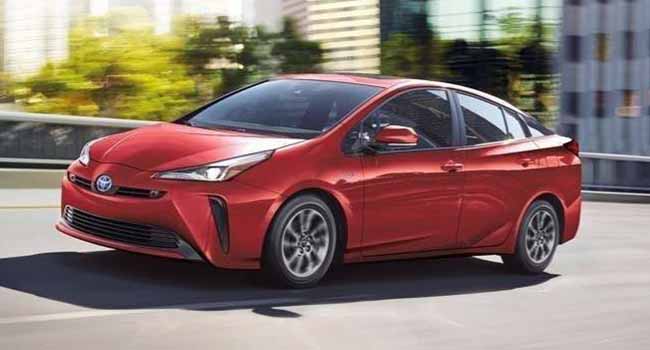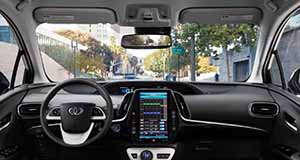
Toyota is on top of its game when it comes to hybrid technology and the Prius’s overwhelming success should be all the proof you need. Available with front-wheel or all-wheel-drive, the 2020 iteration of the Prius develops some 120 horsepower and uses a continuously variable transmission (CVT). It delivers a combined fuel economy of around 4.5 litres/100 km
 Toyoto Prius is the world’s best-selling hybrid vehicle – by a long shot. This is the hybrid against which all others are judged.
Toyoto Prius is the world’s best-selling hybrid vehicle – by a long shot. This is the hybrid against which all others are judged.
Its hybrid drive system is used by Toyota and Lexus throughout their lineups, as well as used under licence by other manufacturers worldwide.
Well over six million Toyota Prius units have gone out of showrooms around the world. And Toyota’s patented Hybrid Synergy Drive system has been fitted to over 12 million vehicles.
Cabbies love the Prius because of its driveability and excellent fuel economy, not to mention durability and surprising storage capacity. I once caught a ride with a Vancouver taxi driver who had one of the first models, from 1999.
Once he learned that I was an automotive writer, I couldn’t shut him up. He told me that he racked up over 500,000 km on the car. His only complaints were a starter button that had to be replaced and the accessory battery, which petered out after five years. That’s not the main lithium battery pack, it’s the auxiliary battery that powers things like the windshield wipers, seat warmers, stereo and so on.
Toyota ended up taking the 1999 car off his hands for examination purposes and replacing it with a 2004 model – gratis. “It didn’t have as big a trunk,” he observed.
Twenty-plus years after the Prius was introduced, it’s still going strong. There have been numerous engineering updates over the years. But in terms of purpose – fuel economy, lower emissions, user-friendliness, reliability, etc. – it’s essentially the same car that first rolled out of the factory in 1999.
And as of the 2020 model year, the battery pack is covered by warranty for up to 240,000 km or 10 years.
Available with either front-wheel or all-wheel-drive, the 2020 iteration of the Prius develops some 120 horsepower and uses a continuously variable transmission (CVT).
It delivers a combined fuel economy of around 4.5 litres/100 km for the front-wheel-drive version (the all-wheel-drive version has slightly higher fuel economy). This is one of the best fuel economy numbers in the industry.
Three driving modes – EV, Eco and Power – allow you to regulate fuel economy to a point, but I suspect most people will just leave it in Eco.
Interior cargo space is adequate but not huge – around 700 litres (25 cubic feet) with the back seat folded, and the rear seats fold flat with absolutely no fuss. More headroom back there would be nice but that’s where the battery pack is so, no.

The 2020 Toyota Prius is all about practicality and common sense, and comfort and convenience features are adequate but not over the top. Heated seats are standard issue on the Prime model. A dash readout lets you keep track of how conservative and sensible your driving is. And when you shut the car off, a little note pops up giving you hints on how you can improve your fuel economy
Driving the Prius is not what you’d call scintillating. If you want to go fast and carve corners, look elsewhere.
This car is all about practicality and common sense, and comfort and convenience features are adequate but not over the top. Heated seats, for example, are standard issue on the Prime model, but there’s no heated steering wheel, which would have been nice.
A dash readout lets you keep track of how conservative and sensible your driving is. And when you shut the car off, a little note pops up giving you hints on how to improve your fuel economy.
One of the most annoying features – actually, one of the very few annoyances – is the beeper that activates whenever you back up. It makes you feel like you’re driving some sort of delivery van and I could do without it.
And it could be my imagination, but this version of the Prius seems louder than I remember. Noise, vibration and harshness (NVH) are a little higher than one would expect – not excessive but definitely noticeable.
I could also quibble about slightly oversensitive brakes that hinder your ability to drive smoothly and seamlessly.
But these are nitpicks. The fact remains that Toyota is on top of its game when it comes to hybrid technology and the Prius’s overwhelming success should be all the proof you need.
2020 Toyota Prius
Engine: 1.8-litre four-cylinder and integrated electric motor
Transmission: continuously variable (CVT)
Drive: front-wheel or all-wheel|
Horsepower: 120
Torque: n/a
Base price: $28,550
Fuel economy: 4.4 litre/100 km city and 4.6 litres/100 km highway, with regular
Some alternatives: Toyota Camry Hybrid, Toyota Corolla Hybrid, Honda Accord Hybrid, Honda Clarity, Hyunda Ioniq, Kia Optima Hybrid, Ford C-Max, Ford Fusion Hybrid, Lexus ES350 Hybrid.
Ted Laturnus writes for Troy Media’s Driver Seat Associate website. An automotive journalist since 1976, he has been named Canadian Automotive Journalist of the Year twice and is past-president of the Automotive Journalists Association of Canada (AJAC).
The views, opinions and positions expressed by columnists and contributors are the author’s alone. They do not inherently or expressly reflect the views, opinions and/or positions of our publication.
